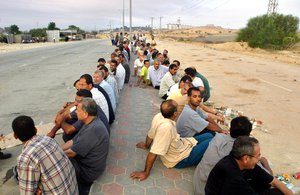
Trail
A trail is usually a path, track or unpaved lane or road, though the term is also applied, in North America, to routes along rivers, and sometimes to highways. In the United Kingdom and the Republic of Ireland path or footpath is the preferred term for a walking trail. Some trails are single use and can only be used for walking, cycling, horse riding, snow shoeing, cross-country skiing, etc., others, as in the case of a bridleway in the UK, are multi-use, and can be used by walkers, cyclists and equestrians.
There are also unpaved trails used by dirt bikes and other off road vehicles. In some places, like the Alps, trails are used for moving cattle and other livestock (see transhumance). In the US historically, the term was used for a route into or through wild territory used by emigrants (e.g. the Oregon Trail).
Usage
In Australia, the term track can be used interchangeably with trail, and can refer to anything from a dirt road to an unpaved pedestrian path. The term trail gained popularity during World War II, when many servicemen from the United States were stationed in Australia, which probably influenced its being adopted by elements of the Australian media at the time (see Kokoda Track).
Glossary of graph theory
This is a glossary of graph theory. Graph theory is the study of graphs, systems of nodes or vertices connected in pairs by edges.
!$@
A
B
C
D
E
F
G
H
I
K
κ(G) is the size of the maximum clique in G; see clique.
L
M
N
O
P
Q
R
S
T
U
V
W
References
Trail (horse show)
Trail is a competitive class at horse shows where horses and riders in western-style attire and horse tack navigate a series of obstacles. Contestants ride the course one at a time. Originally designed to resemble situations a horse and rider might actually encounter when on a trail in a natural habitat, modern trail classes now tend to focus more heavily on agility and manners, with courses bearing very little resemblance to real-world natural trails.
A typical trail course requires horse and rider to open and pass through a small gate while mounted; walk across a fake bridge; cross over a set of rails or logs at a walk, trot or lope; back up, often with a turn while backing; sidepass, often over a rail or log; turn on the forehand or hindquarters within a confined area; and tolerate some type of "spooky" obstacle, such as having the rider put on a vinyl raincoat. The horse is asked to perform all three gaits in the process of completing the course.
Additional obstacles or tests may include walking over a plastic tarp or through water; having the horse ground-tie (remain standing in one spot while the rider walks away); to walk, trot or lope in very tight quarters, such as traveling through a series of cones or markers in a serpentine pattern; or take a small jump (usually under 18 inches, as riders are in western saddles and cannot easily get off the horse's back into a jumping position).

Data segment
In computing, a data segment (often denoted .data) is a portion of an object file or the corresponding virtual address space of a program that contains initialized static variables, that is, global variables and static local variables. The size of this segment is determined by the size of the values in the program's source code, and does not change at run time.
The data segment is read-write, since the values of variables can be altered at run time. This is in contrast to the read-only data segment (rodata segment or .rodata), which contains static constants rather than variables; it also contrasts to the code segment, also known as the text segment, which is read-only on many architectures. Uninitialized data, both variables and constants, is instead in the BSS segment.
Historically, to be able to support memory address spaces larger than the native size of the internal address register would allow, early CPUs implemented a system of segmentation whereby they would store a small set of indexes to use as offsets to certain areas. The Intel 8086 family of CPUs provided four segments: the code segment, the data segment, the stack segment and the extra segment. Each segment was placed at a specific location in memory by the software being executed and all instructions that operated on the data within those segments were performed relative to the start of that segment. This allowed a 16-bit address register, which would normally provide 64KiB (65536 bytes) of memory space, to access a 1MiB (1048576 bytes) address space.
DATA (band)
DATA were an electronic music band created in the late 1970s by Georg Kajanus, creator of such bands as Eclection, Sailor and Noir (with Tim Dry of the robotic/music duo Tik and Tok). After the break-up of Sailor in the late 1970s, Kajanus decided to experiment with electronic music and formed DATA, together with vocalists Francesca ("Frankie") and Phillipa ("Phil") Boulter, daughters of British singer John Boulter.
The classically orientated title track of DATA’s first album, Opera Electronica, was used as the theme music to the short film, Towers of Babel (1981), which was directed by Jonathan Lewis and starred Anna Quayle and Ken Campbell. Towers of Babel was nominated for a BAFTA award in 1982 and won the Silver Hugo Award for Best Short Film at the Chicago International Film Festival of the same year.
DATA released two more albums, the experimental 2-Time (1983) and the Country & Western-inspired electronica album Elegant Machinery (1985). The title of the last album was the inspiration for the name of Swedish pop synth group, elegant MACHINERY, formerly known as Pole Position.
Data (word)
The word data has generated considerable controversy on if it is a singular, uncountable noun, or should be treated as the plural of the now-rarely-used datum.
Usage in English
In one sense, data is the plural form of datum. Datum actually can also be a count noun with the plural datums (see usage in datum article) that can be used with cardinal numbers (e.g. "80 datums"); data (originally a Latin plural) is not used like a normal count noun with cardinal numbers and can be plural with such plural determiners as these and many or as a singular abstract mass noun with a verb in the singular form. Even when a very small quantity of data is referenced (one number, for example) the phrase piece of data is often used, as opposed to datum. The debate over appropriate usage continues, but "data" as a singular form is far more common.
In English, the word datum is still used in the general sense of "an item given". In cartography, geography, nuclear magnetic resonance and technical drawing it is often used to refer to a single specific reference datum from which distances to all other data are measured. Any measurement or result is a datum, though data point is now far more common.
On Any Given Day
(Steven Dale Jones/Gerald Body/Billy Henderson)
(Track 9 - Time 3:34)
On any given day I'll catch myself
Talking to yur memory that's all I have left
I miss you more than words can say
On any given day
Baby, on any given day goin' crazy alone
I'll happen by your place takin' the long way home
You'll drive me out of my way
On any given day
Once you hold an angel in your arms
It's the devil letting go
Just a taste of heaven on earth
Leaves a hunger in your soul
If I had three wishes, I'd throw away two
If I could be certain just one would come true
On any given day, I'd take one more night with you
Once you hold an angel in your arms
It's the devil letting go
Just a taste of heaven on earth
Leaves a hunger in your soul
If I had three wishes, well I'd throw away two
If I could be certain just one would come true
On any given day, I'd take one more night with you
Oh, it's true

Trail
A trail is usually a path, track or unpaved lane or road, though the term is also applied, in North America, to routes along rivers, and sometimes to highways. In the United Kingdom and the Republic of Ireland path or footpath is the preferred term for a walking trail. Some trails are single use and can only be used for walking, cycling, horse riding, snow shoeing, cross-country skiing, etc., others, as in the case of a bridleway in the UK, are multi-use, and can be used by walkers, cyclists and equestrians.
There are also unpaved trails used by dirt bikes and other off road vehicles. In some places, like the Alps, trails are used for moving cattle and other livestock (see transhumance). In the US historically, the term was used for a route into or through wild territory used by emigrants (e.g. the Oregon Trail).
Usage
In Australia, the term track can be used interchangeably with trail, and can refer to anything from a dirt road to an unpaved pedestrian path. The term trail gained popularity during World War II, when many servicemen from the United States were stationed in Australia, which probably influenced its being adopted by elements of the Australian media at the time (see Kokoda Track).
Latest News for: trail data
US manufacturing activity grows at slowest pace since 2016
U.S. manufacturing activity growth in May registers slowest pace in almost 3 yrs
Secular Grower Series: HubSpot
Radar is now reality in the Valley
Valero Should Find Its Way Into Your Portfolio
10 things you need to know before the opening bell (SPY, SPX, QQQ, DIA, TSLA, UBER, BYND, GM)
Privacy Is Class
Better Buy: Square vs. Visa
Get on your wild side
How Fearless Are You in Your Analytics Journey?
- 1
- 2
- Next page »
Article Search
Most Viewed
WorldNews.com | 03 Jun 2019
WorldNews.com | 04 Jun 2019
WorldNews.com | 04 Jun 2019
Belfast Telegraph | 04 Jun 2019





































